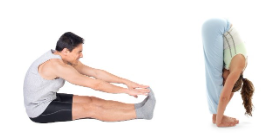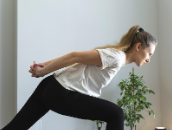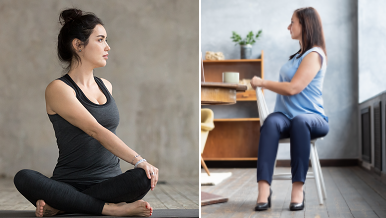
Stretching: It’s Not Just for Warm-ups Anymore!
Unless you are a dancer, or a yogini, stretching is one of those activities that has often been considered a warm-up to something else, or a cool-down after a “real” workout. But stretching is raising its profile now that a series of studies, beginning in 2020, showed that regular stretching is a powerful lifespan extender.
In a large (more than 36,000 people) longitudinal study, published in 2020, it was not surprising that researchers found that certain types of exercise, like walking, aerobics, weightlifting, and stair climbing were associated with lower mortality rates during a 17-year period, even after adjusting for amount of exercise and other health habits. What was surprising was that the two forms of exercise associated with the lowest mortality rates were playing volleyball (go figure!) and stretching!
It turns out that study wasn’t a fluke – at least as it relates to stretching (volleyball isn’t studied often). Follow-up studies during the past four years are reinforcing the benefits of stretching on its own.
In a 2023 study, individuals who engaged in flexibility exercises at least five times a week experienced a compelling 20% lower risk of mortality during the follow-up period compared to those who didn’t stretch at all. This was true even after researchers eliminated any benefits gained from participation in other types of exercise. Stretching actually reduced mortality risk a bit better than the usual health favorites — aerobic exercise and resistance training.
These results have catalyzed a new fitness growth sector, with businesses like Stretch’d, Stretched Out, Stretch Lab, and Stretch Zone cropping up around the country, and the launch of countless stretching apps. But you don’t need apps, classes, or private training to unlock the myriad health benefits of stretching. All you need is consistency and a few minutes each day to reap some real mental and physical rewards.
Types of Stretching
Stretching comes in many forms including passive, active, static, dynamic, isometric, and somatic, but there are only a few you really need to know about.
- Passive stretching is stretching that gets a little help from an outside force in deepening a stretch. This help can come from gravity, as in a forward bend (see below), a strap or towel to help you stretch your arms or legs, or even from a physical therapist who will help you stretch.
- Static stretching and active stretching both depend on the person stretching to do the hard work. Static stretching involves extending a limb to create a stretch sensation and then holding it there — often for 20 to 45 seconds, with your hands, or by leveraging your body weight against a floor or a wall. Most of the starter stretches below are static stretches. Active stretching occurs when you only use the part of the body being stretched to deepen the stretch. For example, if you lie on your back and use your leg muscles to lift one straight leg until you feel a stretch in your hamstrings and keep your leg in that position without help from your arms and hands, that’s active stretching. If you can turn a static stretch into an active stretch, you get the added benefit of some muscle strengthening work with your stretch.
- Dynamic stretching occurs when you stretch your muscles in a full range of motion. Most yoga, particularly flow, or Vinyasa yoga, is dynamic stretching. Walking lunges fall into this category too.
How Does Stretching Improve Health?
All types of stretching have health benefits. Some are obvious but others might surprise you.
- Enhanced Flexibility and Mobility: Stretching increases muscle flexibility, which is needed to maintain a healthy range of motion in the joints. For example, stretching the soft tissues in the back, legs, hamstrings, and hip flexors can improve joint range of motion in the spine. Flexibility and mobility also reduce the risk of falling, which may be one of the reasons stretching is associated with increased lifespan.
- Enhanced Cardiovascular Health: This may not seem obvious, but it turns out stretching increases blood flow to areas of the body that are lacking oxygen and/or nutrients. Stretching also reduces resting heart rate and blood pressure. All of these improve cardiovascular health.
- Stress Relief: Stretching promotes relaxation and alleviates tension, fostering a sense of calm in daily life. Stress reduction has long been associated with improved longevity.
Tips for Creating a Stretching Habit
- Anchor Your Stretching: Identify a consistent time daily to serve as your anchor and prompt you to stretch. For example, you could decide to do a few minutes of stretching before breakfast, or at the end of your lunch break, or right after you end your workday. Consistency is key to getting the health benefits of stretching.
- Introduce Stretching: Once you determine your anchor, decide on a brief series of stretches you plan to do daily. Your first series should be short enough to incorporate easily into your day.
- Add Stretches and Time Slowly: You are likely to find that these stretches feel so great that you want to do more. As you get into your stretching groove, explore additional stretches, or add time to your existing routine. But remember, it is more important to stretch every day than it is to lengthen your practice.
Basic Stretches
To help you get started on your stretching journey, here are five simple stretches that anyone can perform and incorporate into a daily routine. Start by holding each stretch for 20-30 seconds.

Forward Bend:
Stretch your hamstrings and lower back by bending forward from the hips, reaching towards your toes. You can do this sitting or standing, and you don’t have to touch your toes at the beginning. If you do this every day, you will get there.

Chest Opener:
Open up your chest and shoulders by interlacing your fingers behind your back and gently straightening your arms. You can do this a variety of ways, just make sure you feel the stretch and keep your shoulders down..

Quad Stretch:
Stretch the front of your thigh by bending one knee and gently pulling your heel towards your glutes. Feel the stretch for 30 seconds then switch legs.

Seated Spinal Twist:
Promote spinal mobility by twisting the torso gently while seated. You can do this stretch while seated on the floor, in a chair, or even while at your desk during the day. Don’t forget to stretch both sides.

Neck Stretch:
Relieve tension in your neck by gently tilting your head to one side, feeling the stretch along the side of your neck. This is something you may find yourself doing several times a day when you get stiff from phone or computer work. Remember to stretch both sides.
The Bottom Line on Stretching
It turns out that simple stretching can help you feel great and live longer. So why not try to unlock the power of stretching by incorporating it into your daily routine? Remember, small actions performed consistently can lead to remarkable outcomes. And this may be the easiest way to get more movement into your life.
At Amaze we want to help you get healthy and stay healthy. And of course, we’re always here to help.